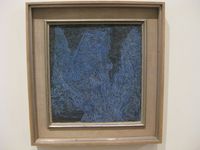Walpurgis Night In Real Life: Difference between revisions
Homerun-chan (talk | contribs) mNo edit summary |
Homerun-chan (talk | contribs) mNo edit summary |
||
| Line 24: | Line 24: | ||
The German artist [[Wikipedia:Paul Klee|Paul Flee]] made in 1935 a painting called "Walpurgisnacht". As stated in [[Episode_8#Observations|the page for Episode 8]], many fans found that this painting bears similarities with Sayaka's transformation sequence. Whether this is intentionnal or not is still unknown. | The German artist [[Wikipedia:Paul Klee|Paul Flee]] made in 1935 a painting called "Walpurgisnacht". As stated in [[Episode_8#Observations|the page for Episode 8]], many fans found that this painting bears similarities with Sayaka's transformation sequence. Whether this is intentionnal or not is still unknown. | ||
{{-}} | |||
==References== | ==References== | ||
Revision as of 19:44, 26 February 2011
This article is a compilation of historical, mythological, and literary information concerning Walpurgisnacht (ワルプルギスの夜 Warupurugisu no Yoru, Night of Walpurgis), a term mentioned for the first time by Homura in Episode 6. Any speculah regarding this subject should be archived here as well.
Usage of the Term in Canon
In Episode 6
During the arcade scene, Homura mentions "Walpurgisnacht," which is the name of a northern European Spring Festival also called "The Night of the Witches."
ほむら: 「2週間後、この街に『ワルプルギスの夜』が来る。『そいつ』さえ倒せたら、私はこの街を出てゆく。」 Homura: "In two weeks, 'Walpurgisnacht' is coming to this town. Once I defeat 'it,' I'll leave."
For clarification, 「そいつ」 -- rendered here in English as 'it' -- is a pronoun that usually refers to a person, and Kyouko's response to Homura made it clear that what was being referred to could be 'defeated.' At present time -- prior to the broadcast of Episode 9 -- it remains unclear if the pronoun used specifically refers to Walpurgisnacht, or whether the term Walpurgisnacht refers to an event or a being (a witch?).
In Episode 8
Documents regarding Walpurgisnacht on display in Homura's apartment contain imagery that strongly resembles the Witch from Episode 1.
Literary & Historical Background
Walpurgis Night in real-life
In Eastern Europe, Walpurgis Night is a night when witches are said to go outside and be particularly troublesome. It is the night from April 30th to May 1st.
Paul Klee's painting
The German artist Paul Flee made in 1935 a painting called "Walpurgisnacht". As stated in the page for Episode 8, many fans found that this painting bears similarities with Sayaka's transformation sequence. Whether this is intentionnal or not is still unknown.
References
Japanese Madoka Wiki
The entry on Walpurgisnacht on the Japanese wiki states the following:
ワルプルギスの夜
- Walpurgis Night
第6話にてほむらが2週間後に来ると告げた物。
- Homura announced in Episode 6 that it would come 2 weeks later
現時点では現象なのか敵の名前なのかも不明。
- At this point, it is still unclear whether it is the name of an event or an enemy
語感からすると現象だが「そいつ」「倒す」「勝つ」などと言われてたことより敵の名前なのかもしれない。ワルプルギスの夜に現れる敵を仮定して言っていたのかもしれないが。
- The sense of the word would make it a phenomenon, but words such as "to defeat", or "to win" could also refer to an ennemy. It might also be possible that ennemies appear during Walpurgis Night.
すでに命名がされており、「二人でなら倒せるかもしれない」などという何らかの前提情報が存在するため、今回が初めてではなく過去に例がある現象であると思われる。
- (translation needed)
実際にはヨーロッパで広く知られてる魔女と死者のお祭り。日本でいうお盆のような物。
- In real-life, it is a widespread European festival for witches and deceased. It is equivalent to the Japanese O-Bon festival.
